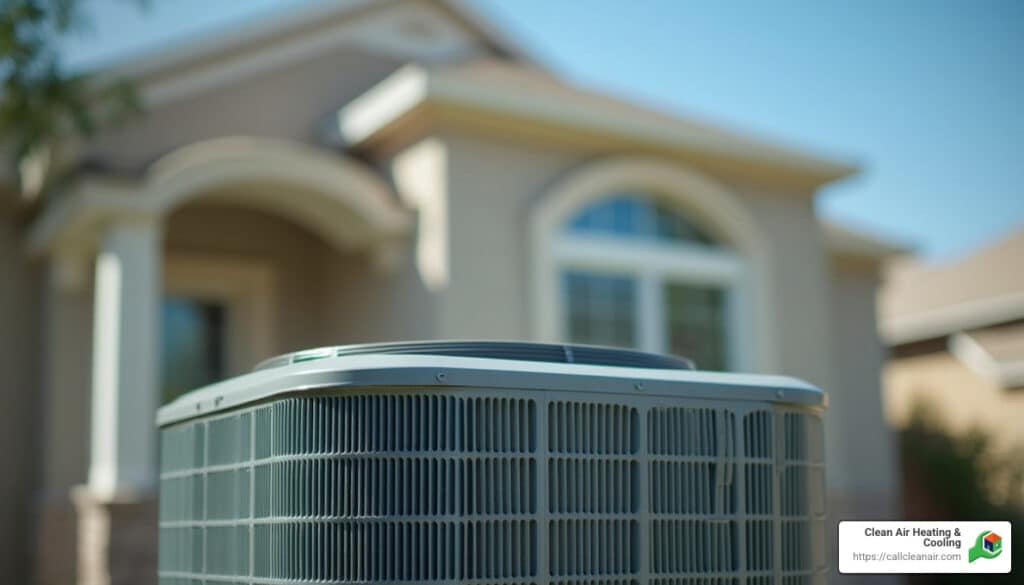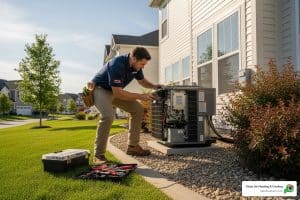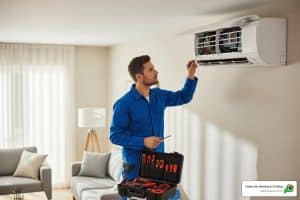AC installation estimate can seem overwhelming, but we’re here to simplify it for you. A successful installation hinges on several factors:
- System Size: Larger homes need larger AC units.
- Efficiency: Higher efficiency units can save on utility bills.
- Installation Complexity: Some homes require more work, like duct and electrical upgrades.
- Furnace Replacement: Often, the furnace needs updating along with the AC for peak performance.
In the heart of Northwest Washington, where temperatures can vary, having a reliable air conditioning system isn’t just about comfort—it’s about maintaining a healthy home environment. Poor systems lead to high energy bills, more frequent repairs, and reduced comfort levels.
I’m Colin Matei, Owner and President of Clean Air Heating & Cooling. With years of experience in AC installation estimate, my team and I are dedicated to bringing the best comfort solutions to our community in Whatcom, Skagit, and Snohomish Counties. Let’s explore understanding all factors that shape an AC installation estimate.

Factors Affecting AC Installation Costs
When considering an AC installation estimate, it’s important to understand the factors that can influence the cost. Let’s break down the key elements that play a role in determining how much you’ll pay for a new AC system.
Tonnage (Size)
The size of your AC unit, measured in tons, is crucial. It refers to the cooling capacity of the system, or how much heat it can remove from your home per hour. For example, a 1-ton AC can remove up to 12,000 BTUs of heat in an hour.
To determine the appropriate size for your home, a professional will conduct a load calculation. This ensures your AC is neither too big nor too small, which can lead to inefficiencies and higher utility bills.
Efficiency Level
An AC’s efficiency is measured by its SEER (Seasonal Energy Efficiency Ratio) rating. The higher the SEER rating, the more efficient the unit. High-efficiency units may cost more upfront but can lead to significant energy savings over time. Consulting with a professional can help you choose a unit that balances efficiency with your budget.
Comfort Features
Modern AC systems offer a variety of comfort features. These can include variable cooling speeds, sound insulation, smart thermostats, and even air purification systems. While these features can increase the cost, they significantly improve comfort and air quality in your home.
Condition of Existing Components
The state of your current HVAC components can impact installation costs. This includes refrigeration lines, electrical circuits, ductwork, and air registers. If these components are outdated or damaged, they may need repairs or replacements, adding to the overall cost.
Furnace Replacement
If your furnace is outdated, replacing it alongside your AC may be necessary for compatibility reasons. Newer AC units often require eco-friendly refrigerants and work best with a variable speed furnace. While this may increase upfront costs, replacing both systems simultaneously can save on labor and improve overall efficiency.

Understanding these factors helps you make informed decisions about your AC installation. In the next section, we’ll explore the types of air conditioning systems available, along with their pros and cons.
Types of Air Conditioning Systems
Choosing the right air conditioning system is crucial for comfort and efficiency. Let’s explore the different types available, along with their pros and cons.
Central Air Conditioner
Central air conditioners are popular for cooling entire homes. They use a system of ducts to distribute cool air. Components include an outdoor condenser, an indoor evaporator coil, and an air handler. Central ACs are known for their efficiency, providing consistent cooling throughout your home.
- Pros: Efficient for whole-house cooling, can increase home value.
- Cons: Requires ductwork, higher installation costs.
Ductless Split System
Ductless split systems offer flexibility by cooling specific areas without ducts. They consist of an outdoor unit and one or more indoor air handlers. Installation is straightforward, making them ideal for homes without existing ductwork.
- Pros: Flexible installation, energy-efficient, zone control.
- Cons: Higher upfront cost, multiple units needed for larger homes.
Window AC Unit
Window AC units are compact and portable, perfect for cooling individual rooms. They are installed in windows and are easy to set up.
- Pros: Affordable, easy installation.
- Cons: Limited to single rooms, can block window views.
Portable AC Unit
Portable AC units are mobile and can be moved from room to room. They require a venting kit to expel hot air through a window.
- Pros: Mobility, no permanent installation.
- Cons: Less efficient, can be noisy.
Heat Pump
Heat pumps provide both cooling and heating, making them versatile for year-round use. They transfer heat from one place to another, rather than generating it.
- Pros: Energy-efficient, year-round use.
- Cons: Higher initial cost, may not be suitable for extremely cold climates.
Gas Pack HVAC System
Gas pack systems combine heating and cooling in one unit. They are typically installed outside, making them space-efficient.
- Pros: Compact design, efficient for small spaces.
- Cons: Limited to areas with gas availability, higher initial cost.
Each system has its unique benefits and drawbacks. Consider your home’s needs and budget when choosing the best option for you. In the next section, we’ll discuss what to expect during an AC installation estimate.
AC Installation Estimate: What to Expect
When planning for an air conditioning installation, understanding the costs involved can help you budget effectively. Here’s what you can expect:
Average Costs
The cost of installing an AC unit can vary widely based on several factors, including the type of system and your home’s specific requirements. On average, AC installation costs range from $3,800 to $7,500, with a typical installation averaging around $5,900. However, depending on the complexity and additional features, the total cost could be anywhere between $4,000 to $20,000.
Labor Costs
Labor is a significant part of the installation cost. Expect to pay between $75 to $250 per hour for professional services. The complexity of the installation and the contractor’s experience can influence this rate. Complex installations that involve extensive ductwork or electrical upgrades may increase labor time and costs.
Permits and Removal
Depending on your location, you might need a permit for the installation, which could add to your costs. Failing to obtain necessary permits can result in fines, so it’s crucial to check local regulations. If you’re replacing an old AC unit, removal costs can range from $25 to $200, depending on the unit’s size and accessibility.
Plumbing and Electrical Work
AC units require proper plumbing and electrical connections. If your home needs new or upgraded systems, expect to pay $100 to $150 each for plumbing and electrical work. This ensures your system operates safely and efficiently, avoiding potential hazards or inefficiencies.
Repairing Existing Ductwork
Even if you have existing ductwork, it might need repairs before a new AC system can function correctly. Repair costs can range from $200 to $1,000. Issues like mold or asbestos may require additional remediation, adding to the overall expense.
Understanding these cost components will help you prepare for an AC installation estimate. In the next section, we’ll guide you on how to get a free estimate and what to expect from professionals during the process.
How to Get a Free AC Installation Estimate
Contacting Professionals
When looking to install a new air conditioning system, reaching out to professionals is a crucial first step. It’s important to ask the right questions to ensure you’re getting the best service and value. Here are some key questions to consider:
- What is included in the estimate? Ensure that the estimate covers all necessary components, including labor, permits, and any potential repairs or upgrades.
- Do you offer any guarantees or warranties? Look for companies that stand behind their work with guarantees, like Clean Air Heating & Cooling’s 25% utility savings guarantee.
- Can you provide references or reviews? Reputable companies should have positive customer feedback. For example, Clean Air Heating & Cooling boasts over 480 5-star reviews.
It’s also wise to gather multiple quotes from different contractors. This helps you compare prices and services, ensuring you make an informed decision. The lowest quote isn’t always the best choice; consider the company’s reputation, experience, and customer service.
What to Expect
Once you’ve contacted a professional, here’s what you can expect from the AC installation estimate process:
- Inspection: A thorough inspection of your home is essential. Technicians will assess your current system (if any), ductwork, and the specific needs of your space.
- Load Calculation: Professionals will perform a load calculation, often referred to as a Manual J calculation, to determine the appropriate size and capacity of the AC unit for your home. This ensures optimal efficiency and comfort.
- Upfront Quote: After the inspection and calculations, you’ll receive an upfront quote detailing the costs. This should include all aspects of the installation, from labor to any necessary upgrades or repairs.
Clean Air Heating & Cooling
If you’re located in Northwest Washington, including Whatcom, Skagit, Snohomish, San Juan Counties, or Bellingham, WA, Clean Air Heating & Cooling is a top choice for your AC installation needs. They offer free estimates, allowing you to understand your options without any initial investment.
With a commitment to customer satisfaction, Clean Air Heating & Cooling guarantees a 25% reduction in your utility costs, ensuring you save money in the long run. Their team is known for being quick to respond, showing up on time, and delivering high-quality work with professionalism. The numerous 5-star reviews from satisfied customers reflect their dedication to excellence.

By choosing a reputable company like Clean Air Heating & Cooling, you can rest assured that your AC installation will be handled by experts who prioritize your comfort and budget.
Frequently Asked Questions about AC Installation Costs
Why does AC install cost so much?
Installing an air conditioning system can seem pricey, and several factors contribute to these costs. One major factor is the ductwork. If your home doesn’t already have ducts, installing them can be expensive. Even if ducts are present, they might need repairs or cleaning, which adds to the cost. Ducts are essential for distributing cool air efficiently, and any issues with them can impact the system’s performance.
Another significant cost factor is the electricity input. Air conditioners require a lot of power, and upgrading your home’s electrical system to handle this demand can increase the overall installation cost. This might involve hiring an electrician to install a dedicated circuit, which is crucial for the safe operation of your AC unit.
What size AC unit do I need for a 2000 square-foot house?
Determining the right size AC unit for your home is crucial for efficiency and comfort. For a 2000 square-foot house, a professional will typically perform a load calculation. This involves assessing various factors, such as the home’s layout, insulation, and climate. The goal is to find the right balance—too small a unit won’t cool effectively, while too large a unit can waste energy.
According to general guidelines, a 2000 square-foot home might need an AC unit with around 3 to 3.5 tons of cooling capacity. This translates to approximately 36,000 to 42,000 BTUs (British Thermal Units). However, these are just rough estimates, and a professional assessment is always recommended to ensure optimal performance.
How much air conditioner do I need for a 5000 square-foot house?
For larger homes, like a 5000 square-foot house, it’s even more important to get the sizing right. The HVAC size chart is a useful tool that professionals use to determine the appropriate capacity based on the home’s size. A home of this size might require an AC unit with 8 to 10 tons of cooling capacity, which equates to about 96,000 to 120,000 BTUs.
Again, a load calculation is essential. This calculation considers factors such as ceiling height, window size, and local climate conditions to ensure the system is neither undersized nor oversized. An accurately sized unit will provide efficient cooling and help keep energy bills in check.
By understanding these key factors, you can better steer the complexities of AC installation and ensure you choose the right system for your needs.
Conclusion
In summary, installing a new air conditioning system is a significant investment, but one that can greatly improve your home’s comfort and energy efficiency. Understanding the various factors that affect installation costs—such as the size and efficiency of the unit, existing ductwork, and electrical requirements—can help you make informed decisions and avoid unexpected expenses.
Professional installation is crucial. It ensures that your system operates safely and efficiently. A professional will conduct a thorough inspection, perform precise load calculations, and provide you with an upfront quote, minimizing surprises down the road. This expertise not only ensures optimal performance but also extends the lifespan of your system.
At Clean Air Heating & Cooling, we pride ourselves on delivering high-quality service with a focus on customer satisfaction. Serving Bellingham, WA, and surrounding counties, our team offers a 25% utility savings guarantee and boasts over 480 5-star reviews. We are committed to making your AC installation process as smooth and cost-effective as possible.
For more information or to schedule a free AC installation estimate, please visit our HVAC Services page. Our experts are ready to help you achieve the comfort you deserve.





